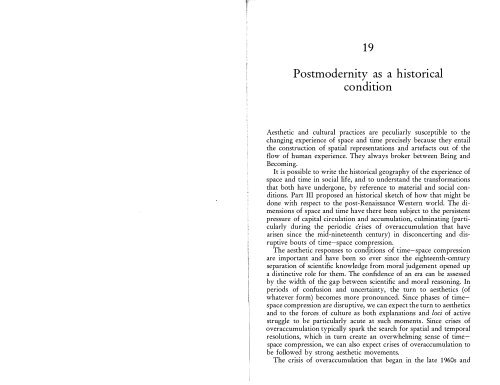The Condition of Postmodernity 13 - autonomous learning
The Condition of Postmodernity 13 - autonomous learning
The Condition of Postmodernity 13 - autonomous learning
You also want an ePaper? Increase the reach of your titles
YUMPU automatically turns print PDFs into web optimized ePapers that Google loves.
19<strong>Postmodernity</strong> as a historicalconditionAesthetic and cultural practices are peculiarly susceptible to thechanging experience <strong>of</strong> space and time precisely because they entailthe construction <strong>of</strong> spatial representations and artefacts out <strong>of</strong> theflow <strong>of</strong> human experience. <strong>The</strong>y always broker between Being andBecoming.It is possible to write the historical geography <strong>of</strong> the experience <strong>of</strong>space and time in social life, and to understand the transformationsthat both have undergone, by reference to material and social conditions.Part III proposed an historical sketch <strong>of</strong> how that might bedone with respect to the post-Renaissance Western world. <strong>The</strong> dimensions<strong>of</strong> space and time have there been subject to the persistentpressure <strong>of</strong> capital circulation and accumulation, culminating (particularlyduring the periodic crises <strong>of</strong> overaccumulation that havearisen since the mid-nineteenth century) in disconcerting and disruptivebouts <strong>of</strong> time-space compression.<strong>The</strong> aesthetic responses to conitions <strong>of</strong> time-space compressionare important and have been so ever since the eighteenth-centuryseparation <strong>of</strong> scientific knowledge from moral judgement opened upa distinctive role for them. <strong>The</strong> confidence <strong>of</strong> an era can be assessedby the width <strong>of</strong> the gap between scientific and moral reasoning. Inperiods <strong>of</strong> confusion and uncertainty, the turn to aesthetics (<strong>of</strong>whatever form) becomes more pronounced. Since phases <strong>of</strong> timespacecompression are disruptive, we can expect the turn to aestheticsand to the forces <strong>of</strong> culture as both explanations and loci <strong>of</strong> activestruggle to be particularly acute at such moments. Since crises <strong>of</strong>overaccumulation typically spark the search for spatial and temporalresolutions, which in turn create an overwhelming sense <strong>of</strong> timespacecompression, we can also expect crises <strong>of</strong> overaccumulation tobe followed by strong aesthetic movements.<strong>The</strong> crisis <strong>of</strong> overaccumulation that began in the late 1960s and
















